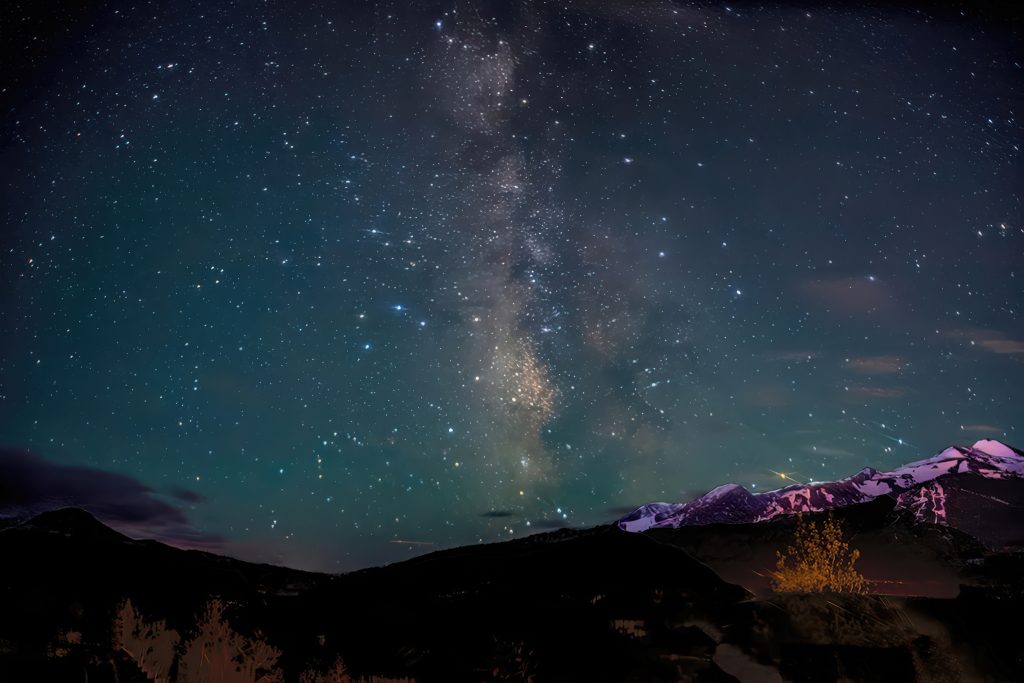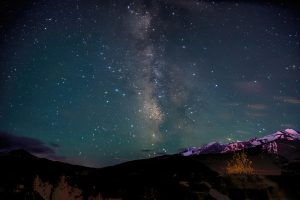Colorado stargazers are in for ‘extra-special’ treats this October with 7 meteor showers and 2 comets
On Oct. 24, there is an ‘extremely rare’ possibility that 2 comets could be visible to the naked eye

Stephen Johnson/Courtesy photo
Colorado nights are getting colder, but stargazers who get outside after dark this October will be rewarded with a smattering of celestial phenomena.
Astronomy guide Mark Laurin — who is better known as Astro Mark — wrote in his monthly stargazing blog that this October is “extra special” because seven meteor showers will reach their peak and two comets could be visible to the naked eye.
“Unquestionably, the October stargazing calendar is full,” Laurin said. “It’s no stretch to say that there are big things happening in the night sky every night this month. From seemingly back-to-back meteor showers to comets galore.”
A mentor with the nonprofit Dark Sky Colorado, Laurin is an advocate for keeping the night sky dark amid the ever-encroaching flood of artificial light in the modern world. He teaches astronomy in conjunction with the Colorado Tourism Center and as an adjunct instructor for the Keystone Science School.
To get the most out of the night sky, Laurin recommends finding a dark spot away from artificial light, powering off phones and other electronic devices and allowing 20 minutes for your eyes to adjust to the darkness.
Meteor showers
A meteor, often called a “shooting star,” is the bright streak of light seen when a small piece of space debris burns up in the atmosphere. A meteor shower occurs when the Earth’s orbit passes through a stream of debris left by a comet, causing a shower of shooting stars as the debris burns up in the atmosphere.
In total, there are seven meteor showers — including two major meteor showers, the Draconids and Orionids — that peak this October, Laurin said. That means there is a good chance to spot a shooting star any night of the month.
“That’s enough flares, streamers, bolides, fireballs, streakers and smokers to light up the entire night sky the entire month,” Laurin said. “That’s beginning to end, start to finish, and every evening in between.”
The Draconid Meteor Shower will peak Oct. 8. Unlike other meteor showers that tend to have the best shooting stars after midnight, the Draconids don’t require stargazers to get outside at “ungodly hours,” Laurin wrote. Instead, the best way to view this meteor shower is just after dusk and to look to the northeast horizon, he said.
With only an estimated five to 10 meteors per hour, Laurin said the Draconid Meteor Shower is not expected to be “exceptional” this year, but the angle at which the debris will hit the atmosphere will make for longer, streamer-type shooting stars. Since the moon was full on Oct. 6, light from the moon could interfere with this meteor shower.
The Orionid Meteor Shower will run from Oct. 2 through Nov. 7, peaking on Oct. 21. During the peak, stargazers can expect between 15 and 20 meteors per hour, Laurin said. To find the meteor shower, he recommended looking eastward after 10:30 p.m. to where the constellation Orion will be rising above the horizon. Then, looking up, keeping a wide angle of the sky, since meteors can come from any direction.
Other meteor showers this month include: the Camelopardalids, which peaked on Oct. 5 with two to four meteors per hour; the Southern Taurids, which peak Oct. 10 with about five meteors per hour; the Delta Aurigids, which peak Oct. 11 with about two meteors per hour; the Epsilon-Geminids, which peak Oct. 18 with about two meteors per hour; and the Leonis Minorids, which peak Oct. 24 with about two meteors per hour.
Comets
The night of Oct. 24 will be an “extremely rare treat,” Laurin said, because it could offer the opportunity to see two comets — the C/2025 R2 Swan and the C/2025 A6 Lemmon — at least one of which will be visible without binoculars or a telescope.
Comets are essentially “dirty snowballs” made up of ice, dust, rock and frozen gases that orbit the sun, according to the National Aeronautics and Space Administration.
The easier comet to find will be the Lemmon comet, since it is expected to be visible without binoculars, Laurin said. Look to the northwest horizon around 7:30 p.m. The comet will be about 10 to 15 degrees off the horizon, which can be estimated by closing one eye and raising a fist to the horizon. He said the comet will look like a “fuzzy patch with a tail.”
Astronomers are uncertain how bright the Swan comet will shine, so binoculars may or may not be necessary to spot the Swan comet, Laurin said. To find the Swan comet, look for the three brightest stars in the southwestern sky. The three stars, part of the constellation Aquila, will create a diagonal line pointed downward. Stargazers who follow the line created by the stars will find the Swan comet.
The Lemmon comet should be visible for several days starting Oct. 21 for about a three-hour window after sunset, Laurin noted. While clouds and light pollution could impact views of the comet, Laurin noted that there will be a new moon on Oct. 21, so light from the moon will not impact the visibility of the comet.

Support Local Journalism

Support Local Journalism
Readers around Glenwood Springs and Garfield County make the Post Independent’s work possible. Your financial contribution supports our efforts to deliver quality, locally relevant journalism.
Now more than ever, your support is critical to help us keep our community informed about the evolving coronavirus pandemic and the impact it is having locally. Every contribution, however large or small, will make a difference.
Each donation will be used exclusively for the development and creation of increased news coverage.










